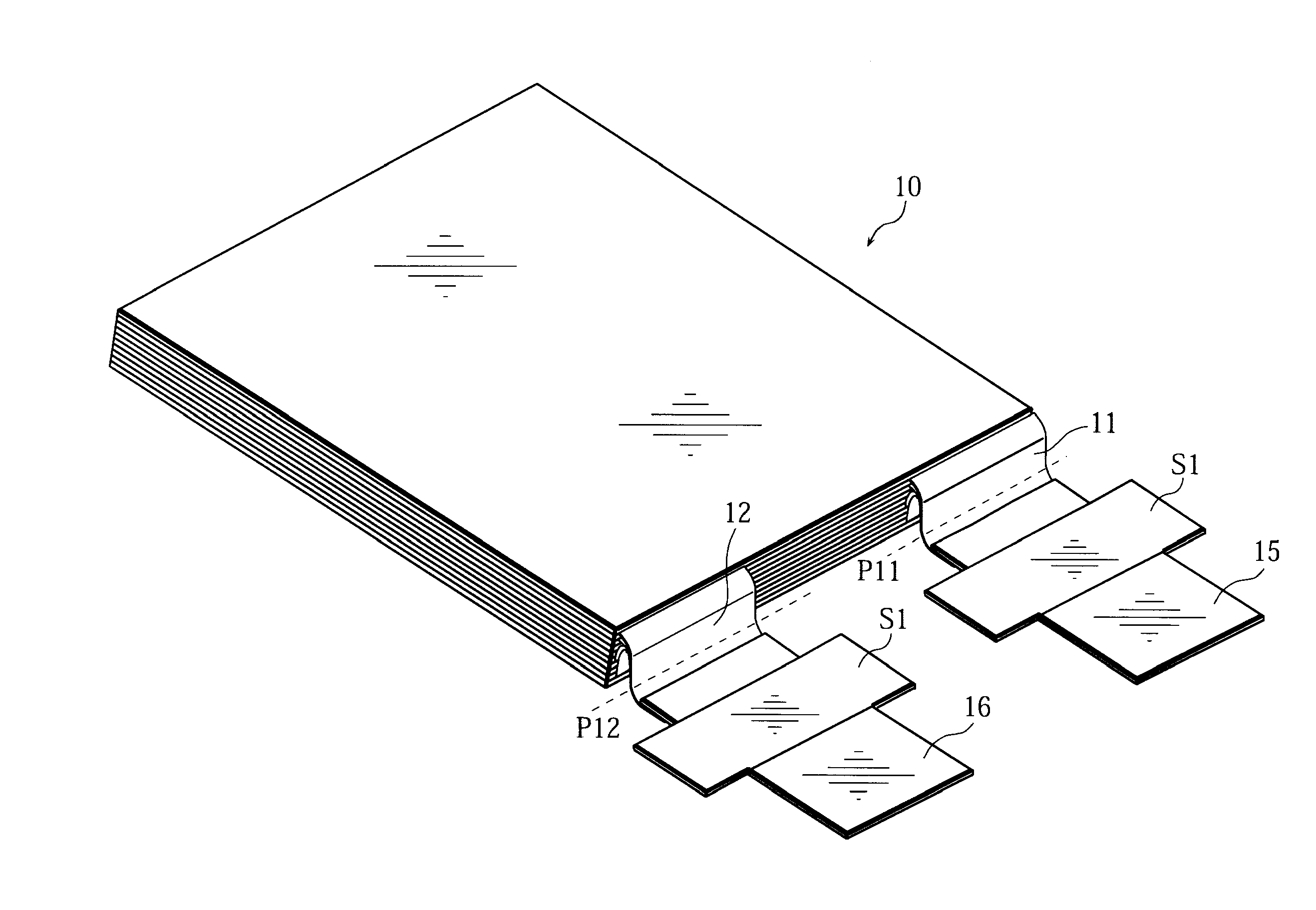Stack type battery
a stack type, battery technology, applied in the direction of cell components, sustainable manufacturing/processing, final product manufacturing, etc., can solve the problems of creases and warpages in the battery case, easy formation of gaps between the electrode assembly and the battery case, and poor welding ability of the welded portions between the metal foils and the metal plate, so as to effectively prevent the construction of a stack type battery
- Summary
- Abstract
- Description
- Claims
- Application Information
AI Technical Summary
Benefits of technology
Problems solved by technology
Method used
Image
Examples
example 1
[0079]A stack type battery fabricated in the same manner as described in the foregoing embodiment was used as the stack type battery of this example.
[0080]The battery fabricated in this manner is hereinafter referred to as Battery A1 of the invention.
[0081]In the following examples and the drawings, parts and components that are or similar to those described in the foregoing embodiment and Example 1 above as well as in FIGS. 1 through 11 are denoted by like reference numerals and symbols, and no further details thereof are given unless necessary.
example 2
[0082]As illustrated in FIG. 12, a first spacer 56 and a second spacer 55 were individually formed so as to have the same configurations as the first cover portion 52 and the second cover portion 51, respectively, of the integral-type spacer 5 in Battery A1 of the invention. The first spacer 56 and the second spacer 55 are laterally long members having the same cross-sectional shape as each other. Needless to say, neither of the first spacer 56 and the second spacer 55 has a part that corresponds to the connecting piece 53 of the integral-type spacer 5 in Battery A1 of the invention. A stack type battery was fabricated in the same manner as the foregoing Battery A1 of the invention, except that the first spacer 56 and the second spacer 55 were individually disposed at the same locations as the first cover portion 52 and the second cover portion 51 were disposed in the integral-type spacer 5 of Battery A1 of the invention.
[0083]The battery fabricated in this manner is hereinafter ref...
example 3
[0098]A stack type battery was fabricated in the same manner as the foregoing Battery A2 of the invention, except that positive and negative electrode lead tabs 57 and 58 did not employ the two-stage connection structure, i.e., the positive and negative electrode lead tabs 57 and 58 were connected to positive and negative electrode current collector terminals 59 and 60 without being bent, and that the first spacer was not provided.
[0099]The battery fabricated in this manner is hereinafter referred to as Battery A3 of the invention.
[0100]In the just-described Battery A3 of the invention, it was observed that when the battery case 18 was vacuum-sealed in the process of filling the electrolyte solution and sealing the battery case, misalignment of the second spacer 55 occurred, causing small creases and slight warpage in the battery case 18. However, the second spacer 55 prevented the battery case 18 from being forced into or dented at the portion (the current collector-side end) furth...
PUM
 Login to View More
Login to View More Abstract
Description
Claims
Application Information
 Login to View More
Login to View More - R&D
- Intellectual Property
- Life Sciences
- Materials
- Tech Scout
- Unparalleled Data Quality
- Higher Quality Content
- 60% Fewer Hallucinations
Browse by: Latest US Patents, China's latest patents, Technical Efficacy Thesaurus, Application Domain, Technology Topic, Popular Technical Reports.
© 2025 PatSnap. All rights reserved.Legal|Privacy policy|Modern Slavery Act Transparency Statement|Sitemap|About US| Contact US: help@patsnap.com



